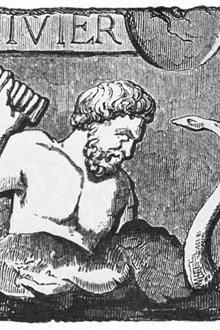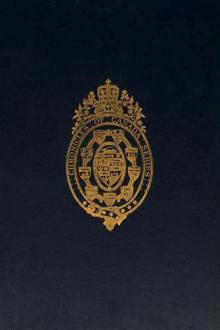Three Thousand Years of Mental Healing by George Barton Cutten (best large ereader txt) 📕

- Author: George Barton Cutten
- Performer: -
Book online «Three Thousand Years of Mental Healing by George Barton Cutten (best large ereader txt) 📕». Author George Barton Cutten
The gift of St. Peter's knife to a German monastery by a benevolent abbot was deemed a most illustrious act. About the same time a noble pilgrim succeeded, after great importunity and a lavish outlay of money, in obtaining trifling particles of the relics of Abraham, Isaac, and Jacob, which he enclosed in a priceless box and donated to the monastery of St. Gall. This gift was considered the greatest event of the year, but when it is considered that this and similar presents insure in the community, where they are deposited uninterrupted peace, unstinted plenty, absence of catastrophies, and the cure of diseases, their value is explained.
The commercial aspect of ecclesiastical cures, however, was discovered by other than priestly or monkish eyes, and different forms began to be presented. Of these White says: "Very important among these was the Agnus Dei, or piece of wax from the Paschal candles, stamped with the figure of a lamb and consecrated by the Pope. In 1471 Pope Paul II expatiated to the Church on the efficacy of this fetich in preserving men from fire, shipwreck, tempest, lightning, and hail, as well as in assisting women in childbirth; and he reserved to himself and his successors the manufacture of it. Even as late as 1517 Pope Leo X issued, for a consideration, tickets bearing a cross and the following inscription: 'This cross measured forty times makes the height of Christ in his humanity. He who kisses it is preserved for seven days from falling-sickness, apoplexy, and sudden death.'"49
The enormous revenues procured through the means of relics, and the lack of certain means of identifying them, would naturally encourage the imposition of fraud. The crime would not appear so great after one experience, for the perpetrators could readily see that it really made no difference so far as efficacy in the cure of diseases was concerned, whether or not the relics were genuine. The history of some of the relics unfortunately proves them not to be relics at all, or at least not to be the relics which the faithful supposed them to be. Notice a few instances. In a magnificent shrine in the cathedral at Cologne are the skulls of the three kings, or wise men from the East, who brought gifts to the infant Lord. They have rested here since the twelfth century and have been the source of enormous wealth and power to the cathedral chapter. Not to be outdone by the cathedral, for the church of St. Gereon a cemetery has been depopulated, and the bones thus procured have been placed upon the walls and are known as the relics of St. Gereon and his Theband band of martyrs! Further competition arose in the neighboring church of St. Ursula. Another cemetery was despoiled and the bones covering the interior of the walls are known as the relics of St. Ursula and her eleven thousand virgin martyrs. Anatomists now declare that many of the bones are those of men, but this made no more difference in their healing efficacy in the Middle Ages than the fact that the relics of St. Rosalia at Palermo, famed for their healing power, have lately been declared by Professor Buckland, the eminent osteologist, to be the bones of a goat.
Two different investigations have been conducted by the French courts concerning the fountain of La Salette, and in both cases the miracles which make the shrine famous were pronounced to be fraudulent. The recent restoration of the cathedral at Trondhjem has revealed a tube in the walls, not unlike the apparatus discovered in the Temple of Isis at Pompeii; the healing power of this sacred spring was augmented by angelic voices which issued from the supposedly solid walls.50
While the golden age of the therapeutic use of relics was from the sixth to the sixteenth centuries, modern times, with its physicians, hospitals, and drugs, has not been deprived of this method of cure. Mackay, writing in the latter half of the past century, touches this subject.
At Port Royal, in Paris, is kept with great care a thorn, which the priests of that seminary assert to be one of the identical thorns that bound the holy head of the Son of God. How it came there, and by whom it was preserved, has never been explained. This is the famous thorn which the long dissensions of the Jansenists and the Molenists have made celebrated, and which worked the miraculous cure upon Mademoiselle Perier, an account of which is so interesting that I give it. The cure occurred on March 14, 1646.
"A young pensioner in the monastery, by name Margaret Perier, who for three years and a half had suffered from a lachrymal fistula, came up in her turn to kiss it; and the nun, her mistress, more horrified than ever at the swelling and deformity of her eye, had a sudden impulse to touch the sore with the relic, believing that God was sufficiently able and willing to heal her. She thought no more of the matter, but the little girl having retired to her room, perceived a quarter of an hour after that her disease was cured; and when she told her companions, it was indeed found that nothing more was to be seen of it. There was no more tumor; and her eye, which the swelling (continuous for three years) had weakened and caused to water, had become as dry, as healthy, as lively as the other. The spring of the filthy matter, which every quarter of an hour ran down from nose, eye, and mouth, and at the very moment before the miracle had fallen upon her cheek (as she declared in her deposition), was found to be quite dried up; the bone, which had been rotted and putrified, was restored to its former condition; all the stench, proceeding from it, which had been so insupportable that by order of the physicians and surgeons she was separated from her companions, was changed into a breath as sweet as an infant's; and she recovered at the same moment her sense of smell....
"Mons. Felix, Chief Surgeon to the King, who had seen her during the month of April, was curious enough to return on the 8th of August, and having found the cure as thorough and marvellous as it had seemed to him at the time, declared under his hand that 'he was obliged to confess that God alone had the power to produce an effect so sudden and extraordinary.'"51
Mackay gives the following account of the distribution of relics about the middle of the nineteenth century: "Europe still swarms with these religious relics. There is hardly a Roman Catholic Church in Spain, Portugal, France, or Belgium, without one or more of them. Even the poorly endowed churches of the villages boast the possession of miraculous thighbones of the innumerable saints of the Romish calendar. Aix-la-Chapelle is proud of the veritable châsse, or thighbone of Charlemagne, which cures lameness. Halle has a thighbone of the Virgin Mary; Spain has seven or eight, all said to be undoubted relics. Brussels at one time preserved, and perhaps does now, the teeth of St. Gudule. The faithful who suffered from the toothache, had only to pray, look at them, and be cured."52
The miracles performed at the tomb of the Deacon Paris in the cemetery of St. Médard are of comparatively recent occurrence, and well attested. For example, we have the case of "la demoiselle Coirin," which, to say the least, is out of the ordinary. "In 1716," says Dearmer, "this lady, then aged thirty-one, fell from her horse; paralysis and an ulcer followed; by 1719 the ulcer was in a horrible condition; in 1720 her mother refused an operation preferring to let her die in peace. In 1731—after fifteen years of an open breast—she asked a woman to say a novena at the tomb of François de Paris, to touch the tomb with her shift, and to bring back some earth. This was done on August 10th; on the 11th she put on the shift and at once felt improved; on the 12th she touched the wound with the earth and it at once began to heal. By the end of August the skin was completely healed up, and on September 24th she went out of doors."53
Among the most noted relics at the present time are the Holy Coat of Treves,54 the Winding-sheet of Christ at Besançon, and the Santa Scala at Rome. The last are said to be the steps which Jesus ascended and descended when he was brought before Pontius Pilate, and are held in great veneration. It is sacrilegious to walk upon them; the knees of the faithful alone must touch them, and that only after they have reverently kissed them. Cures are still performed by all these relics.
The two shrines at present best known and which have proved most efficacious are those of Lourdes in France55 and St. Anne de Beaupré in the province of Quebec. Lourdes owes its reputed healing power to a belief in a vision of the Virgin received there during the last century. Over 300,000 persons visit there every year, and no small proportion of them return with health restored as a reward for their faith. At Lourdes and many other shrines bathing forms a part of the ceremony, and on account of the unsanitary conditions in the former place, there is some danger that the French Government will cause its abandonment. Charcot, who established the Salpétrière hospital where hypnotism was so successfully used, sent fifty or sixty patients to Lourdes every year. He was firmly convinced of the healing power of faith. One commendable feature of the management at Lourdes is the opportunity given for investigation; in fact, this is courted. Most of the sick bring medical details of their diseases; an examining committee of medical men examine them after they arrive there and after the cure. About two hundred and fifty doctors visit there every year, and the widest opportunity is given to them for examination of the cases, regardless of their nationality or religious belief or scepticism. This attitude might well be assumed by these in control of other shrines or of healing cults.
In America thousands flock to the shrine of St. Anne de Beaupré annually. Here are to be found bones, supposed to be the wrist bones of the holy mother of the Virgin, and many sufferers are able to testify to their value in the healing of various diseases.
On all parts of the Continent there are shrines of more or less renown as healing centres. In Normandy the springs of Fécamp or Grand-Andely are much frequented; in Austria, at Mariazell, Styria, the church is visited by two hundred thousand pilgrims a year, and has been a centre of healing since 1157; in Italy, the church of S. Maria dell' Arco, near Naples, has been a local Lourdes for four hundred years, and here, as at Amalfi, Palermo, and other places, the ancient practice of incubation is still prevalent. The adherents of the Eastern Church also have their shrines, and among the visitors to the shrines of Greece, many pilgrims are rewarded for their faith by being healed.
It is curious to remark the avidity manifested in all ages, and in all countries, to obtain possession of some relic of any person who had been much spoken of, if for nothing more than for his crimes.56 Snuff-boxes made from Shakespeare's mulberry-tree, twigs from Napoleon's willow, or bullets from the field of Waterloo have all been much sought





Comments (0)